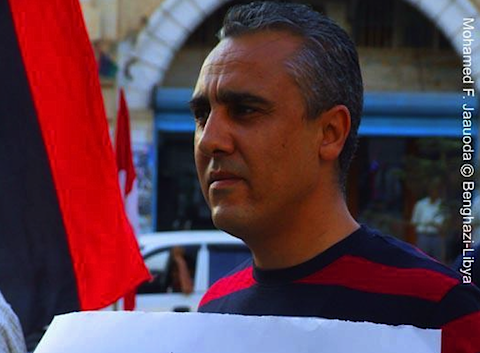By George Grant.

Tripoli, 3 December:
Assassins narrowly failed in an attempt to murder the organiser of the Save Benghazi Friday protest this . . .[restrict]morning, killing his young brother-in-law instead.
Naji Hamad was the driving force behind the enormous anti-militia demonstration that swept through Benghazi on 21 September in the wake of the fatal attack on the American consulate in Benghazi that killed US Ambassador to Libya Christpher Stevens and three of his staff ten days earlier.
“He was walking out of his home this morning when a group of men opened fire”, said Bilal Bettamir, another of the Save Benghazi organisers. “They hit his brother-in-law Anees Al-Jahani and he died. He was only 19 or 20 years old. He was an artist and he was innocent”.
Bettamir says that Hamad had received a number of death threats in the past few months on account of his active and high-profile campaigning against militia rule in the eastern city.
A serving police officer who now teaches at the Benghazi Police Academy, Hamad nevertheless did not employ bodyguards in the wake of the threats, and Bettamir believes that today’s failed assassination will not be the end of the story.
“After Naji, I am next in line for another assassination. I was his partner in organising save Benghazi Friday. He has been my teacher and mentor for the past five years.”
Over the past year, Benghazi has witnessed a spate of assassinations and failed attempts against senior members of the security services, the vast majority of whom served in some capacity under the former regime.
Eighteen officers have been killed in this manner so far this year, with the most recent being the city’s police chief Faraj Drissi on 21 November. Many now believe that these killings are part of an organised campaign of targeted assassination perpetrated by Islamist militants in the city.
Although today’s failed assassination against Hamad is reckoned to have had more to do with his involvement in the Save Benghazi demonstration – he was a traffic officer before the revolution – it nevertheless highlights the dangers of challenging militia rule in the cradle of last year’s uprising.
Anywhere between 30,000-40,000 people came onto the streets for the 21 September demonstration, an unprecedented show of public force against the city’s militias. Later that evening, protesters stormed and briefly occupied the compounds of three Islamist brigades, Rafah Al-Sahati, the 17 February Brigade and the Ansar Al-Shariah brigade.
Members of Ansar Al-Shariah are reckoned to have been primarily responsible for the US Consulate attack, and the militia was disbanded shortly after the incident, although its members have not been disarmed. [/restrict]










